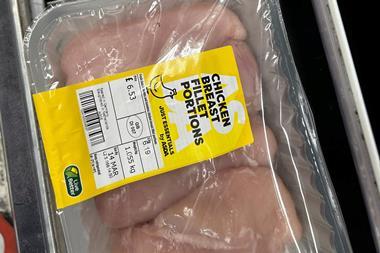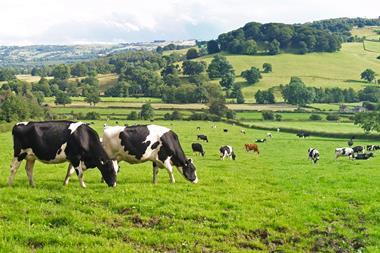Chris Walkland looks at what’s happening to the 3.5ppl milk price rises and why some farmers might not get a fair share
The fight to raise milk prices took several weeks, but, against the odds, the battle was won - Asda and Tesco increased the price of milk in-store by 2p per pint (3.5ppl) in early March and Morrisons, Sainsbury, Waitrose and Somerfield soon followed.
But one victorious battle doesn’t win a war, and the focus has now moved to trying to secure rises in other sectors.
The rationale is simple: supply chain costs have increased significantly for all processors and farmers, and the request was for the chain as a whole to help pay them. For the processors, best estimates suggest there has been a 33% increase in energy costs since last spring, and a 50% rise in high-density polyethylene.
For farmers, wage costs have risen by 15%, feed by 7% and fertiliser by 30%. The National Farmers’ Union estimates there has been an overall cost rise of 1.7ppl. It was on the back of these rises that the cross-industry campaign began.
Of the 3.5ppl, there is apparently 1ppl each for retailers and processors, and 1.5ppl for farmers. However, it isn’t that simple - while all retailers are insisting on their portion, not all have agreed to give the processors their share, according to a senior trade source.
And if all farmers are to receive their share of the rises, then all dairy market sectors must move their prices, including the long-life and cheese markets. If they don’t, some farmers will get a significant part of the 1.5ppl price rise, while others will get nothing.
That’s because the volume of liquid milk sold by supermarkets accounts for only about a quarter of the total UK market. Defra estimates that an increase of 1ppl in the supermarket price for liquid milk results in a rise in the average farm-gate price of 0.3ppl. On that basis, assuming no movement elsewhere, the liquid rise will result in an average farm-gate increase of less than 0.5ppl.
Farmers enjoying the bulk of the rise will be those supplying dedicated liquid dairies.
Arla’s price has been spread across all its milk partnership members and not just reserved for the liquid milk suppliers. This has diluted its rise to 0.75ppl so far. The dilution effect is the same for others with multiple portfolios. Dairy Crest, First Milk and DFB all increased their March prices by 0.3ppl, as did Milk Link on the back of long-life milk increases. Dairy Crest will also up its April price by 0.6ppl, while Robert Wiseman has put up its price by 0.9ppl.
Given the previous smoke-and-mirrors nature of milk price determination, some observers are concerned that the increases will not be passed back to farmers in full. Such fears featured in the price initiatives of 2003, although the industry was effectively cleared by the All-Party Select Committee.
But the NFU says lack of transparency is unlikely to be an issue now. “Previous price rise initiatives bypassed the processors. This one doesn’t, and is for clear, tangible reasons,” says NFU policy adviser Tom Hind.
Many companies are injecting greater transparency into their milk pricing. Dairy Crest, for one, has “provided a detailed, transparent schedule supporting our calculations to key members of the Dairy Crest Direct board and to First Milk. These calculations demonstrate that we have passed back the increases in full.”
Despite such assurances, however, many farmers are still smarting over the increase in retailer margins. According to official figures, in 1993 the average supermarket margin on milk was 1.3ppl. By 2003 this had risen to 13ppl, and last year’s re-tendering process is thought to have increased it by another 2ppl to 15ppl.
Dairy consultant John Allen of Kite is worried that the rises could be eroded. “The need for these rises is clear cut. But initiatives have failed in the past, and this one is more likely to do so if the cheese market doesn’t move as well,” says Allen.
>>p70 UHT milk prices rise
The fight to raise milk prices took several weeks, but, against the odds, the battle was won - Asda and Tesco increased the price of milk in-store by 2p per pint (3.5ppl) in early March and Morrisons, Sainsbury, Waitrose and Somerfield soon followed.
But one victorious battle doesn’t win a war, and the focus has now moved to trying to secure rises in other sectors.
The rationale is simple: supply chain costs have increased significantly for all processors and farmers, and the request was for the chain as a whole to help pay them. For the processors, best estimates suggest there has been a 33% increase in energy costs since last spring, and a 50% rise in high-density polyethylene.
For farmers, wage costs have risen by 15%, feed by 7% and fertiliser by 30%. The National Farmers’ Union estimates there has been an overall cost rise of 1.7ppl. It was on the back of these rises that the cross-industry campaign began.
Of the 3.5ppl, there is apparently 1ppl each for retailers and processors, and 1.5ppl for farmers. However, it isn’t that simple - while all retailers are insisting on their portion, not all have agreed to give the processors their share, according to a senior trade source.
And if all farmers are to receive their share of the rises, then all dairy market sectors must move their prices, including the long-life and cheese markets. If they don’t, some farmers will get a significant part of the 1.5ppl price rise, while others will get nothing.
That’s because the volume of liquid milk sold by supermarkets accounts for only about a quarter of the total UK market. Defra estimates that an increase of 1ppl in the supermarket price for liquid milk results in a rise in the average farm-gate price of 0.3ppl. On that basis, assuming no movement elsewhere, the liquid rise will result in an average farm-gate increase of less than 0.5ppl.
Farmers enjoying the bulk of the rise will be those supplying dedicated liquid dairies.
Arla’s price has been spread across all its milk partnership members and not just reserved for the liquid milk suppliers. This has diluted its rise to 0.75ppl so far. The dilution effect is the same for others with multiple portfolios. Dairy Crest, First Milk and DFB all increased their March prices by 0.3ppl, as did Milk Link on the back of long-life milk increases. Dairy Crest will also up its April price by 0.6ppl, while Robert Wiseman has put up its price by 0.9ppl.
Given the previous smoke-and-mirrors nature of milk price determination, some observers are concerned that the increases will not be passed back to farmers in full. Such fears featured in the price initiatives of 2003, although the industry was effectively cleared by the All-Party Select Committee.
But the NFU says lack of transparency is unlikely to be an issue now. “Previous price rise initiatives bypassed the processors. This one doesn’t, and is for clear, tangible reasons,” says NFU policy adviser Tom Hind.
Many companies are injecting greater transparency into their milk pricing. Dairy Crest, for one, has “provided a detailed, transparent schedule supporting our calculations to key members of the Dairy Crest Direct board and to First Milk. These calculations demonstrate that we have passed back the increases in full.”
Despite such assurances, however, many farmers are still smarting over the increase in retailer margins. According to official figures, in 1993 the average supermarket margin on milk was 1.3ppl. By 2003 this had risen to 13ppl, and last year’s re-tendering process is thought to have increased it by another 2ppl to 15ppl.
Dairy consultant John Allen of Kite is worried that the rises could be eroded. “The need for these rises is clear cut. But initiatives have failed in the past, and this one is more likely to do so if the cheese market doesn’t move as well,” says Allen.
>>p70 UHT milk prices rise
















No comments yet